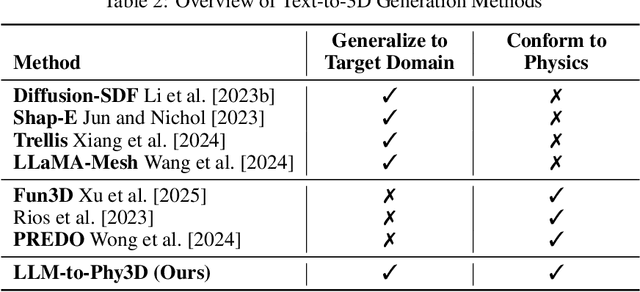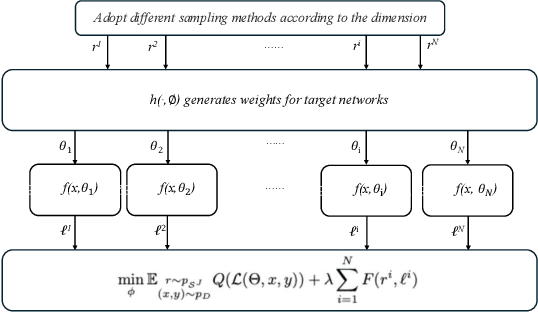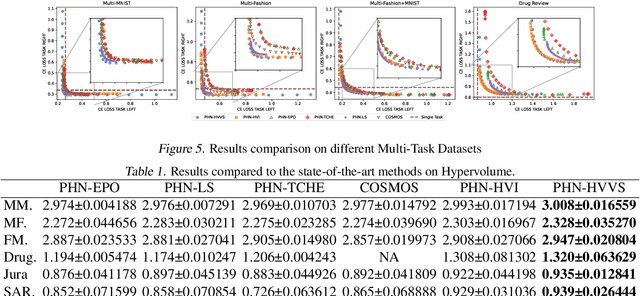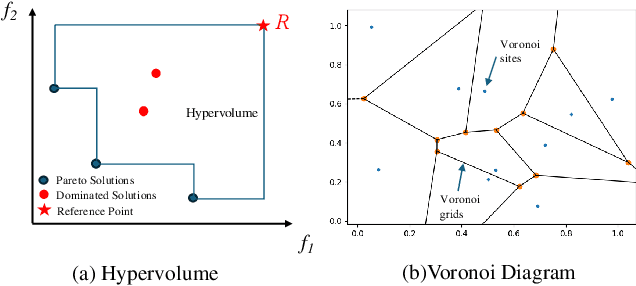Yew-Soon Ong
Parametric Expensive Multi-Objective Optimization via Generative Solution Modeling
Nov 17, 2025Abstract:Many real-world applications require solving families of expensive multi-objective optimization problems~(EMOPs) under varying operational conditions. This gives rise to parametric expensive multi-objective optimization problems (P-EMOPs) where each task parameter defines a distinct optimization instance. Current multi-objective Bayesian optimization methods have been widely used for finding finite sets of Pareto optimal solutions for individual tasks. However, P-EMOPs present a fundamental challenge: the continuous task parameter space can contain infinite distinct problems, each requiring separate expensive evaluations. This demands learning an inverse model that can directly predict optimized solutions for any task-preference query without expensive re-evaluation. This paper introduces the first parametric multi-objective Bayesian optimizer that learns this inverse model by alternating between (1) acquisition-driven search leveraging inter-task synergies and (2) generative solution sampling via conditional generative models. This approach enables efficient optimization across related tasks and finally achieves direct solution prediction for unseen parameterized EMOPs without additional expensive evaluations. We theoretically justify the faster convergence by leveraging inter-task synergies through task-aware Gaussian processes. Meanwhile, empirical studies in synthetic and real-world benchmarks further verify the effectiveness of our alternating framework.
NeuSpring: Neural Spring Fields for Reconstruction and Simulation of Deformable Objects from Videos
Nov 11, 2025Abstract:In this paper, we aim to create physical digital twins of deformable objects under interaction. Existing methods focus more on the physical learning of current state modeling, but generalize worse to future prediction. This is because existing methods ignore the intrinsic physical properties of deformable objects, resulting in the limited physical learning in the current state modeling. To address this, we present NeuSpring, a neural spring field for the reconstruction and simulation of deformable objects from videos. Built upon spring-mass models for realistic physical simulation, our method consists of two major innovations: 1) a piecewise topology solution that efficiently models multi-region spring connection topologies using zero-order optimization, which considers the material heterogeneity of real-world objects. 2) a neural spring field that represents spring physical properties across different frames using a canonical coordinate-based neural network, which effectively leverages the spatial associativity of springs for physical learning. Experiments on real-world datasets demonstrate that our NeuSping achieves superior reconstruction and simulation performance for current state modeling and future prediction, with Chamfer distance improved by 20% and 25%, respectively.
Distributional Multi-objective Black-box Optimization for Diffusion-model Inference-time Multi-Target Generation
Oct 30, 2025Abstract:Diffusion models have been successful in learning complex data distributions. This capability has driven their application to high-dimensional multi-objective black-box optimization problem. Existing approaches often employ an external optimization loop, such as an evolutionary algorithm, to the diffusion model. However, these approaches treat the diffusion model as a black-box refiner, which overlooks the internal distribution transition of the diffusion generation process, limiting their efficiency. To address these challenges, we propose the Inference-time Multi-target Generation (IMG) algorithm, which optimizes the diffusion process at inference-time to generate samples that simultaneously satisfy multiple objectives. Specifically, our IMG performs weighted resampling during the diffusion generation process according to the expected aggregated multi-objective values. This weighted resampling strategy ensures the diffusion-generated samples are distributed according to our desired multi-target Boltzmann distribution. We further derive that the multi-target Boltzmann distribution has an interesting log-likelihood interpretation, where it is the optimal solution to the distributional multi-objective optimization problem. We implemented IMG for a multi-objective molecule generation task. Experiments show that IMG, requiring only a single generation pass, achieves a significantly higher hypervolume than baseline optimization algorithms that often require hundreds of diffusion generations. Notably, our algorithm can be viewed as an optimized diffusion process and can be integrated into existing methods to further improve their performance.
Lightweight and Accurate Multi-View Stereo with Confidence-Aware Diffusion Model
Sep 18, 2025Abstract:To reconstruct the 3D geometry from calibrated images, learning-based multi-view stereo (MVS) methods typically perform multi-view depth estimation and then fuse depth maps into a mesh or point cloud. To improve the computational efficiency, many methods initialize a coarse depth map and then gradually refine it in higher resolutions. Recently, diffusion models achieve great success in generation tasks. Starting from a random noise, diffusion models gradually recover the sample with an iterative denoising process. In this paper, we propose a novel MVS framework, which introduces diffusion models in MVS. Specifically, we formulate depth refinement as a conditional diffusion process. Considering the discriminative characteristic of depth estimation, we design a condition encoder to guide the diffusion process. To improve efficiency, we propose a novel diffusion network combining lightweight 2D U-Net and convolutional GRU. Moreover, we propose a novel confidence-based sampling strategy to adaptively sample depth hypotheses based on the confidence estimated by diffusion model. Based on our novel MVS framework, we propose two novel MVS methods, DiffMVS and CasDiffMVS. DiffMVS achieves competitive performance with state-of-the-art efficiency in run-time and GPU memory. CasDiffMVS achieves state-of-the-art performance on DTU, Tanks & Temples and ETH3D. Code is available at: https://github.com/cvg/diffmvs.
Routing Distilled Knowledge via Mixture of LoRA Experts for Large Language Model based Bundle Generation
Aug 24, 2025Abstract:Large Language Models (LLMs) have shown potential in automatic bundle generation but suffer from prohibitive computational costs. Although knowledge distillation offers a pathway to more efficient student models, our preliminary study reveals that naively integrating diverse types of distilled knowledge from teacher LLMs into student LLMs leads to knowledge conflict, negatively impacting the performance of bundle generation. To address this, we propose RouteDK, a framework for routing distilled knowledge through a mixture of LoRA expert architecture. Specifically, we first distill knowledge from the teacher LLM for bundle generation in two complementary types: high-level knowledge (generalizable rules) and fine-grained knowledge (session-specific reasoning). We then train knowledge-specific LoRA experts for each type of knowledge together with a base LoRA expert. For effective integration, we propose a dynamic fusion module, featuring an input-aware router, where the router balances expert contributions by dynamically determining optimal weights based on input, thereby effectively mitigating knowledge conflicts. To further improve inference reliability, we design an inference-time enhancement module to reduce variance and mitigate suboptimal reasoning. Experiments on three public datasets show that our RouteDK achieves accuracy comparable to or even better than the teacher LLM, while maintaining strong computational efficiency. In addition, it outperforms state-of-the-art approaches for bundle generation.
Context-Adaptive Graph Neural Networks for Next POI Recommendation
Jun 12, 2025Abstract:Next Point-of-Interest (POI) recommendation is a critical task in location-based services, aiming to predict users' next visits based on their check-in histories. While many existing methods leverage Graph Neural Networks (GNNs) to incorporate collaborative information and improve recommendation accuracy, most of them model each type of context using separate graphs, treating different factors in isolation. This limits their ability to model the co-influence of multiple contextual factors on user transitions during message propagation, resulting in suboptimal attention weights and recommendation performance. Furthermore, they often prioritize sequential components as the primary predictor, potentially undermining the semantic and structural information encoded in the POI embeddings learned by GNNs. To address these limitations, we propose a Context-Adaptive Graph Neural Networks (CAGNN) for next POI recommendation, which dynamically adjusts attention weights using edge-specific contextual factors and enables mutual enhancement between graph-based and sequential components. Specifically, CAGNN introduces (1) a context-adaptive attention mechanism that jointly incorporates different types of contextual factors into the attention computation during graph propagation, enabling the model to dynamically capture collaborative and context-dependent transition patterns; (2) a graph-sequential mutual enhancement module, which aligns the outputs of the graph- and sequential-based modules via the KL divergence, enabling mutual enhancement of both components. Experimental results on three real-world datasets demonstrate that CAGNN consistently outperforms state-of-the-art methods. Meanwhile, theoretical guarantees are provided that our context-adaptive attention mechanism improves the expressiveness of POI representations.
LLM-to-Phy3D: Physically Conform Online 3D Object Generation with LLMs
Jun 11, 2025



Abstract:The emergence of generative artificial intelligence (GenAI) and large language models (LLMs) has revolutionized the landscape of digital content creation in different modalities. However, its potential use in Physical AI for engineering design, where the production of physically viable artifacts is paramount, remains vastly underexplored. The absence of physical knowledge in existing LLM-to-3D models often results in outputs detached from real-world physical constraints. To address this gap, we introduce LLM-to-Phy3D, a physically conform online 3D object generation that enables existing LLM-to-3D models to produce physically conforming 3D objects on the fly. LLM-to-Phy3D introduces a novel online black-box refinement loop that empowers large language models (LLMs) through synergistic visual and physics-based evaluations. By delivering directional feedback in an iterative refinement process, LLM-to-Phy3D actively drives the discovery of prompts that yield 3D artifacts with enhanced physical performance and greater geometric novelty relative to reference objects, marking a substantial contribution to AI-driven generative design. Systematic evaluations of LLM-to-Phy3D, supported by ablation studies in vehicle design optimization, reveal various LLM improvements gained by 4.5% to 106.7% in producing physically conform target domain 3D designs over conventional LLM-to-3D models. The encouraging results suggest the potential general use of LLM-to-Phy3D in Physical AI for scientific and engineering applications.
MermaidFlow: Redefining Agentic Workflow Generation via Safety-Constrained Evolutionary Programming
May 29, 2025Abstract:Despite the promise of autonomous agentic reasoning, existing workflow generation methods frequently produce fragile, unexecutable plans due to unconstrained LLM-driven construction. We introduce MermaidFlow, a framework that redefines the agentic search space through safety-constrained graph evolution. At its core, MermaidFlow represent workflows as a verifiable intermediate representation using Mermaid, a structured and human-interpretable graph language. We formulate domain-aware evolutionary operators, i.e., crossover, mutation, insertion, and deletion, to preserve semantic correctness while promoting structural diversity, enabling efficient exploration of a high-quality, statically verifiable workflow space. Without modifying task settings or evaluation protocols, MermaidFlow achieves consistent improvements in success rates and faster convergence to executable plans on the agent reasoning benchmark. The experimental results demonstrate that safety-constrained graph evolution offers a scalable, modular foundation for robust and interpretable agentic reasoning systems.
Voronoi-grid-based Pareto Front Learning and Its Application to Collaborative Federated Learning
May 27, 2025



Abstract:Multi-objective optimization (MOO) exists extensively in machine learning, and aims to find a set of Pareto-optimal solutions, called the Pareto front, e.g., it is fundamental for multiple avenues of research in federated learning (FL). Pareto-Front Learning (PFL) is a powerful method implemented using Hypernetworks (PHNs) to approximate the Pareto front. This method enables the acquisition of a mapping function from a given preference vector to the solutions on the Pareto front. However, most existing PFL approaches still face two challenges: (a) sampling rays in high-dimensional spaces; (b) failing to cover the entire Pareto Front which has a convex shape. Here, we introduce a novel PFL framework, called as PHN-HVVS, which decomposes the design space into Voronoi grids and deploys a genetic algorithm (GA) for Voronoi grid partitioning within high-dimensional space. We put forward a new loss function, which effectively contributes to more extensive coverage of the resultant Pareto front and maximizes the HV Indicator. Experimental results on multiple MOO machine learning tasks demonstrate that PHN-HVVS outperforms the baselines significantly in generating Pareto front. Also, we illustrate that PHN-HVVS advances the methodologies of several recent problems in the FL field. The code is available at https://github.com/buptcmm/phnhvvs}{https://github.com/buptcmm/phnhvvs.
Safe Delta: Consistently Preserving Safety when Fine-Tuning LLMs on Diverse Datasets
May 17, 2025Abstract:Large language models (LLMs) have shown great potential as general-purpose AI assistants across various domains. To fully leverage this potential in specific applications, many companies provide fine-tuning API services, enabling users to upload their own data for LLM customization. However, fine-tuning services introduce a new safety threat: user-uploaded data, whether harmful or benign, can break the model's alignment, leading to unsafe outputs. Moreover, existing defense methods struggle to address the diversity of fine-tuning datasets (e.g., varying sizes, tasks), often sacrificing utility for safety or vice versa. To address this issue, we propose Safe Delta, a safety-aware post-training defense method that adjusts the delta parameters (i.e., the parameter change before and after fine-tuning). Specifically, Safe Delta estimates the safety degradation, selects delta parameters to maximize utility while limiting overall safety loss, and applies a safety compensation vector to mitigate residual safety loss. Through extensive experiments on four diverse datasets with varying settings, our approach consistently preserves safety while ensuring that the utility gain from benign datasets remains unaffected.
 Add to Chrome
Add to Chrome Add to Firefox
Add to Firefox Add to Edge
Add to Edge